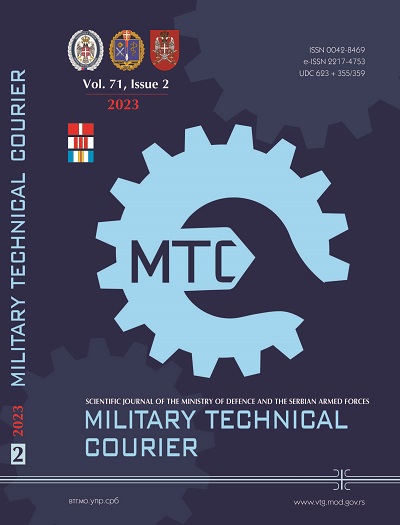Numerical methods and their application in dynamics of structures
Abstract
Introduction/purpose: The aim of this paper is to analyse the numerical methods for solving differential equations of dynamic equilibrium in technical problems.
Methods: The paper gives an overview of the following numerical methods: the method of central difference, the method of linear acceleration, the Newmark method, and the Wilson θ method.
Results: Various problems in applying numerical methods in dynamics of structures have been solved.
Conclusion: It has been shown that the application of numerical methods has a fundamental importance in dynamics of structures.
References
Anahory Simoes, A., Ferraro, S.J., Marrero, J.C. & Martín de Diego, D. 2023. A nonholonomic Newmark method. Journal of Computational and Applied Mathematics, 421, art.number:114873. Available at: https://doi.org/10.1016/j.cam.2022.114873.
Bamer, F., Shirafkan, N., Cao, X., Oueslati, A., Stoffel, G., Saxcé, M. & Markert, B. 2021. A Newmark space-time formulation in structural dynamics. Computational Mechanics, 67, pp.1331-1348. Available at: https://doi.org/10.1007/s00466-021-01989-4.
Bathe, K.-J. 2014. Finite Element Procedures, 2nd edition. New Jersey: Prentice-Hall. ISBN: 978-0-9790049-0-2.
Clough, R.W. & Penzien, J. 2015. Dynamics of Structures, 2nd edition. Berkeley, CA, USA: Computers & Structures, Inc. ISBN: 978-0923907518.
Dhatt, G. & Touzot, G.1984. The Finite Element Method Displayed, 1st edition. Norwich: John Wiley & Sons. ISBN: 978-0471901105.
Esen, I. 2017. A Modified FEM for Transverse and Lateral Vibration Analysis of Thin Beams Under a Mass Moving with a Variable Acceleration. Latin American Journal of Solids and Structures, 14(3), pp.485-511. Available at: https://doi.org/10.1590/1679-78253180.
Hassan, W.M. 2019. Numerical error assessment in nonlinear dynamic analysis of structures. HBRC Journal, 15(1), pp.1-31. Available at: https://doi.org/10.1080/16874048.2019.1619257.
Hoffman, J.D. 2001. Numerical methods for Engineers and Scientists, 2nd edition. New York, NY, USA: Marcel Dekker. ISBN: 0-8247-0443-6.
Jin, X, Ma, Q. & Li, S. 2004. Comparison of four numerical methods for calculating seismic dynamic response of sdof system. In: 13th World Conference on Earthquake Engineering, Vancouver, B.C., Canada, Paper No. 2889, August 1-6 [online]. Available at: http://www.iitk.ac.in/nicee/wcee/article/13_2889.pdf [Accessed: 10 February 2023].
Karimi, Y., Rashahmadi, S. & Hasanzadeh, R. 2018. The Effects of Newmark Method Parameters on Errors in Dynamic Extended Finite Element Method Using Response Surface Method. International Journal of Engineering, 31(1), pp.50-57 [online]. Available at: https://www.ije.ir/article_73091.html [Accessed: 10 February 2023].
Liu, G., Lv, Z.R. & Chen, Y.M. 2018. Improving Wilson-θ and Newmark-β Methods for Quasi-Periodic Solutions of Nonlinear Dynamical Systems. Journal of Applied Mathematics and Physics, 6(8), pp.1625-1635. Available at: https://doi.org/10.4236/jamp.2018.68138.
Mohammadzadeh, S., Ghassemieh, M. & Park, Y. 2017. Structure-dependent improved Wilson-θ method with higher order of accuracy and controllable amplitude decay. Applied Mathematical Modelling, 52, pp.417-436. Available at: https://doi.org/10.1016/j.apm.2017.07.058.
Newmark, N.M. 1959. A Method of Computation for Structural Dynamics. Journal of the Engineering Mechanics Division, 85(3), pp.67-94. Available at: https://doi.org/10.1061/JMCEA3.0000098.
Noh, G. & Bathe, K.J. 2019. For direct time integrations: A comparison of the Newmark and ρ∞-Bathe schemes. Computers & Structures, 225, art.number:106079, pp.1-12. Available at: https://doi.org/10.1016/j.compstruc.2019.05.015.
Rao, S.S. 2001. Applied Numerical Methods for Engineers and Scientists, 1st edition. Hoboken, NJ, USA: Prentice Hall. ISBN: 978-0130894809.
Subbaraj, K. & Dokainish, M.A. 1989. A survey of direct time integration methods in computational structural dynamics − Part II. Implicit methods. Computers & Structures, 32(6), pp.1387-1401. Available at: https://doi.org/10.1016/0045-7949(89)90315-5.
Tapia Andrade, A. & Torres Berni, W. 2021. Evaluation of the dynamic properties of a 2D-frame (MDOF) in a shake table. Ingenius, 26, pp.49-62. Available at: https://doi.org/10.17163/ings.n26.2021.05.
Vasiljevic, R. 2020. Transverse and longitudinal vibrations of a frame structure due to a moving trolley and the hoisted object using moving finite element. Journal of Theoretical and Applied Mechanics, 58(4), pp.825-839. Available at: https://doi.org/10.15632/jtam-pl/126755.
Vasiljević, R., Gašić, M. & Savković, M. 2016. Parameters Influencing the Dynamic Behaviour of the Carrying Structure of a Type H Portal Crane. Strojniški Vestnik/Journal of Mechanical Engineering, 62(10), pp.591-602. Available at: https://doi.org/10.5545/sv-jme.2016.3553.
Wilson, E.I. 2001. Three-Dimensional Static and Dynamic Analysis of Structures, 3rd edition. Berkeley, CA, USA: Computers and Structures Inc. ISBN: 978-0-923907-00-9.
Wolfram, S. 2003. The Mathematica Book, 5th edition. Champaign, IL, USA: Wolfram Media. ISBN: 978-1–57955–022–3.
Wu, J.-J. 2008. Transverse and longitudinal vibrations of a frame structure due to a moving trolley and the hoisted object using moving finite element. International Journal of Mechanical Sciences, 50(4), pp.613-625. Available at: https://doi.org/10.1016/j.ijmecsci.2008.02.001.
Copyright (c) 2023 Rade R. Vasiljević

This work is licensed under a Creative Commons Attribution 4.0 International License.
Proposed Creative Commons Copyright Notices
Proposed Policy for Military Technical Courier (Journals That Offer Open Access)
Authors who publish with this journal agree to the following terms:
Authors retain copyright and grant the journal right of first publication with the work simultaneously licensed under a Creative Commons Attribution License that allows others to share the work with an acknowledgement of the work's authorship and initial publication in this journal.
- Authors are able to enter into separate, additional contractual arrangements for the non-exclusive distribution of the journal's published version of the work (e.g., post it to an institutional repository or publish it in a book), with an acknowledgement of its initial publication in this journal.
- Authors are permitted and encouraged to post their work online (e.g., in institutional repositories or on their website) prior to and during the submission process, as it can lead to productive exchanges, as well as earlier and greater citation of published work (See The Effect of Open Access).

